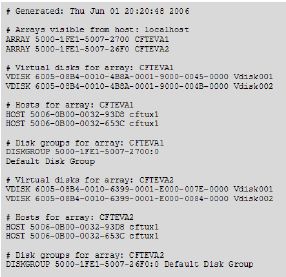Pre-requisites for Using the HP EVA Perf Component
To begin array monitoring using the EVAPerf tool, ensure that the HP Command View EVAPerf component is configured properly:
-
EVA Data Collection service
- The service uses TCP port 860. You may need to open this port on your firewall.
- The service is set to manual start when you install HP Command View EVAPerf.
- When the test runs the HP Command View EVAPerf command line interface, the service starts and remains running until you reboot the host.
- Set the service to start automatically if you use Windows Performance Monitor for background logging. If you execute logging before starting this service, the startup time for the service may exceed the time that Windows Performance Monitor waits for the .rst data samples.
- You can also start and stop the service using Windows Service Manager.
-
Array
- Ensure that the array for which you want to gather performance metrics is initialized. Metrics will not be collected for uninitialized arrays.
- HP recommends that you use unique names for each array.
Moreover, the eG tests that invoke the EVAPerf component for collecting performance metrics, should be configured with the following:
- The install directory of the executable, evaperf.exe – by default, this will be C:\Program Files\Hewlett-Packard\EVA Performance Monitor directory on the host;
-
The WWN (world wide name) or the friendly name of the array to be monitored. To know the friendly name of an array, open the fnames.conf file in the install directory of the EVAPerf tool. The sample contents of this file have been provided below:

Figure 1 : The fnames.conf file
The fnames.conf file (see Figure 1) includes a Arrays visible from host section that reveals the WWN and friendly name of each array on a particular management server running the HP Command View EVA – in Figure 1 above, localhost is the management server name. The entries in this section are of the following format:
ARRAY <WWN of Array> <Friendly name of array>
For instance, in Figure 1, 5000-1FE1-5007-2700 is the WWN of the array, and the cfteva1 is the friendly name of this array.



